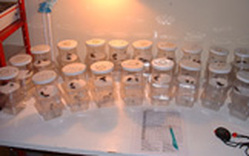What happens in the lab doesn’t have to stay in the lab
|
Laboratory tests have become very important for studying animal behaviour. Yet these tests are rarely compared with tests on the same individuals in the wild, to ensure that what is measured reflects natural behaviour. Being confident that lab studies are relevant is very important for understanding why animal behaviour varies among- and within-individuals and species as much as it does.
|
We set out to plug this gap, and found that for two traits, activity and exploration, there is a positive correlation between what a cricket does in the lab and what it does the next day in the wild. This is a really useful confirmation that our laboratory tests accurately represent natural behaviour.
However, for boldness (willingness to risks), crickets’ scores in the lab were completely unrelated to what they did in the wild afterwards. Our lab boldness test: how quickly a cricket comes out of an artificial burrow, is used to test a variety hypotheses across the world, involving sex differences, immune responses and responses to predation. If it does not reflect a cricket’s boldness in the wild, researchers may not be measuring what they think they are.
Download our paper on this work here
However, for boldness (willingness to risks), crickets’ scores in the lab were completely unrelated to what they did in the wild afterwards. Our lab boldness test: how quickly a cricket comes out of an artificial burrow, is used to test a variety hypotheses across the world, involving sex differences, immune responses and responses to predation. If it does not reflect a cricket’s boldness in the wild, researchers may not be measuring what they think they are.
Download our paper on this work here


